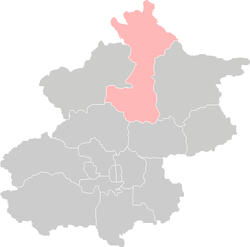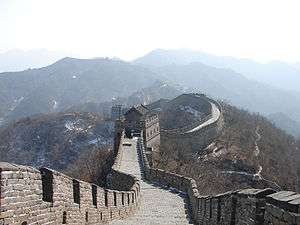Huairou District
| Huairou 怀柔区 | |
|---|---|
| District | |
|
Mutianyu Great Wall | |
 Location of Huairou District in Beijing | |
| Coordinates: 40°18′53.928″N 116°37′33.24″E / 40.31498000°N 116.6259000°E | |
| Country | People's Republic of China |
| Municipality | Beijing |
| Township-level divisions |
2 subdistricts 12 towns 2 ethnic townships |
| Area | |
| • Total | 2,557.3 km2 (987.4 sq mi) |
| Population (2000) | |
| • Total | 296,002 |
| • Density | 120/km2 (300/sq mi) |
| Time zone | China Standard (UTC+8) |
| Area code(s) | 0010 |
| Website |
bjhr |
Huairou District (simplified Chinese: 怀柔区; traditional Chinese: 懷柔區; pinyin: Huáiróu Qū) is situated in northern Beijing. Huairou District, covering an area of 2,557.3 square kilometres (987.4 sq mi), is divided into 2 subdistricts of the city of Huairou, 12 towns and 2 ethnic rural townships with a population of 296,002 (2000 Census). It is 50 kilometers from the city center (about a 1½ to 2 hour drive); 90 percent of it is mountainous area. Its major agricultural products are chestnuts, walnuts, hawthorns, sweet pears, and apricots.
Administrative divisions
There are 2 subdistricts, 12 towns with 3 towns of which carry the "area" (地区) label, and 2 ethnic townships in the district:[1][2]
| Name | Chinese (S) | Hanyu Pinyin | Population (2010)[3] | Area (km2) |
|---|---|---|---|---|
| Longshan Subdistrict | 龙山街道 | Lóngshān Jiēdào | 44,203 | 7.50 |
| Quanhe Subdistrict | 泉河街道 | Quánhé Jiēdào | 54,471 | 5.10 |
| Huairou Area | 怀柔地区 | Huáiróu Dìqū | 66,485 | 69.00 |
| Yanqi Area | 雁栖地区 | Yànqī Dìqū | 25,933 | 154.08 |
| Miaocheng Area | 庙城地区 | Miàochéng Dìqū | 34,027 | 32.70 |
| Beifang Town | 北房镇 | Běifáng Zhèn | 24,541 | 42.10 |
| Yangsong Town | 杨宋镇 | Yángsòng Zhèn | 24,642 | 30.50 |
| Qiaozi Town | 桥梓镇 | Qiáozǐ Zhèn | 21,914 | 112.62 |
| Huaibei Town | 怀北镇 | Huáiběi Zhèn | 12,475 | 104.72 |
| Tanghekou Town | 汤河口镇 | Tānghékǒu Zhèn | 6,372 | 225.09 |
| Bohai Town | 渤海镇 | Bóhǎi Zhèn | 14,016 | 192.02 |
| Jiuduhe Town | 九渡河镇 | Jiǔdùhé Zhèn | 15,206 | 177.40 |
| Liulimiao Town | 琉璃庙镇 | Liúlímiào Zhèn | 5,938 | 226.30 |
| Baoshan Town | 宝山镇 | Bǎoshān Zhèn | 8,244 | 250.45 |
| Changxiaoying Manchu Ethnic Township | 长哨营满族乡 | Zhǎngshàoyíng Mǎnzú Xiāng | 6,570 | 249.43 |
| Labagoumen Manchu Ethnic Township | 喇叭沟门满族乡 | Lǎbāgōumén Mǎnzú Xiāng | 4,895 | 302.00 |
Communities
There is a police station and a school in Shayu (沙峪).[4]
Sancha (三岔) is 6 miles (9.7 km) from Shayu, and a drive from central Beijing to Sancha would take about two hours. There were over 300 people living in Sancha in the 1970s. The Sancha school closed by the early 1990s. By 2001 the population had decreased to 150. That year there were no business operations, including shops and restaurants, in Sancha.[4]
Overview
Huairou's urban area (112,662 in township) has an estimated area of 11.5 km2 (4.4 sq mi) and an estimated population of 90,000.[5]
Huairou District is known for being one of the most important water sources in the capital city earmarked for protection. Because of its 69% forest cover, the district is known as the natural “oxygen bar” of Beijing. In addition, it boasts a rich combination of plant, animal and tourism resources. Therefore, Huairou is of great importance to Beijing in ensuring the environmental quality and the ecosystem of the capital city.
The city center of the Huairou District includes a lake with a walking trail and bike trail for recreation. At the top of the trail there is a pagoda overlooking the lake.
Huairou also holds two American fast food restaurants (McDonalds and KFC) and a theater for showing movies in the Chinese language. Chinese food restaurants are plentiful and are not hard to find no matter what part of Huairou one is in.
The main shopping center goes by the name of "Da Shi Jie" or "Big World." It is a multi-story medium-sized mall with a food court on the top floor. Many of the teens in Huairou enjoy spending time there.
Much of the housing in Huairou consists of six-floor apartment buildings, with the exception of houses in the farming and smaller surrounding areas. There are a number of beautiful resort hotels on the outskirts of town on the way to The Great Wall.
Huairou can also boast the first ever Broadway show funded by their government to christen the newly built state-of-the-art Huairou Theatre (2009). "Race For Love" (later changed to "Reel to Real" for a limited engagement revival run in 2010) starring Jeremy Benton, Ellen Zolezzi featuring Shaun Parry, Autumn Guzzardi and Jose Luaces, was directed by renowned Broadway Director/Choreographer Lynne Taylor-Corbett with musical direction by Douglas Oberhamer. Production and licensing rights are held by Broadway Asia International.
Huairou District lies about 20 kilometers from a portion of the Great Wall of China. The portion of the wall is labeled as "The Great Wall at Mutianyu." Another tourist attraction is Hong Luo Mountain on which the Hong Luo Temple is located.
In 1995 during the United Nation's 4th World's Women Conference in Beijing, the Civil Society community was forced to meet in the Huairou district, an hour from the official proceedings, leading to a great deal of discontent, as many of the non-governmental actors present felt marginalized. In a tent at the Civil Society Village established especially for poor, grassroots women at the conference (organized by GROOTS International), the Huairou Commission, a registered non-governmental organization with a global secretariat in Brooklyn, NY, was established to ensure that grassroots women would have a voice at subsequent UN conferences and in other development processes.[6]
In 2005 a website documenting the 1995 Huairou NGO Forum, a temporary town of 30,000 women, was launched. (http://www.womenstown.org) The site aims to be a resources for teaching and learning about gender and the built environment and is coordinated and edited by an international collective of women. "Looking at the built form of that town, and the activities within it, one sees many of the issues women around the globe encounter in their everyday lives."
Gallery
- Huairou No.1 Middle School
Notes
- ↑ These towns are officially classified as subdistricts, but as they coincide with the area of the same name, they are commonly named "areas" (地区)
- ↑ 2011年统计用区划代码和城乡划分代码:怀柔区 (in Chinese). National Bureau of Statistics of the People's Republic of China. Retrieved 2013-08-07.
- ↑ shi, Guo wu yuan ren kou pu cha ban gong; council, Guo jia tong ji ju ren kou he jiu ye tong ji si bian = Tabulation on the 2010 population census of the people's republic of China by township / compiled by Population census office under the state; population, Department of; statistics, employment statistics national bureau of (2012). Zhongguo 2010 nian ren kou pu cha fen xiang, zhen, jie dao zi liao (Di 1 ban. ed.). Beijing Shi: Zhongguo tong ji chu ban she. ISBN 978-7-5037-6660-2.
- 1 2 Hessler, Peter. "The Wonder Years" (Archive). The New Yorker. March 31, 2008. Retrieved on August 5, 2015.
- ↑ China (CN) Beijing Metropolitan Province
- ↑ Huairou Commission website
External links
| Wikivoyage has a travel guide for Huairou. |
![]() Media related to Huairou District at Wikimedia Commons
Media related to Huairou District at Wikimedia Commons
- Official website of Huairou District
- Official website of Huairou District (simplified Chinese)
